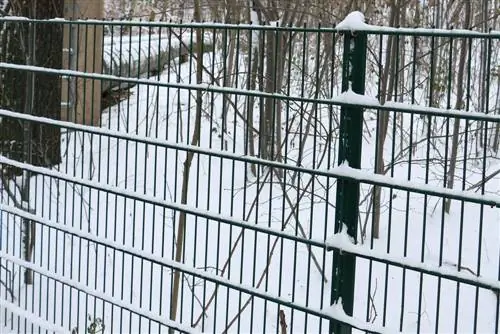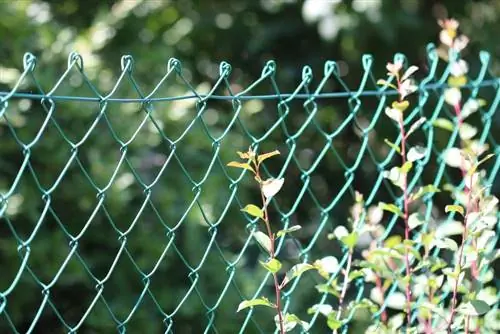- Author admin [email protected].
- Public 2023-12-17 03:39.
- Last modified 2025-06-01 06:48.
A fence is almost as important to your garden design as the lawn. It prevents unauthorized persons from entering your property and protects privacy. In order to be able to make optimal use of your own garden, the fencing is usually erected directly on the property boundary - and in many cases this causes dissatisfaction, anger or even arguments. But what can you actually build at the border and is a real fence actually allowed? We provide information about the legal framework and different perspectives.
Private law vs. public law
What is allowed and what is not is stipulated in German law for many subject matters and even individual cases. But if you think that everything is clearly defined and can be easily read, you are wrong. Because different areas of law have their own perspectives on the same topic and can come to very different results. The biggest difference when it comes to the fence on the property boundary is the basic division into private law and public law.
Public Law
The legal relationships between the state and an individual, in our case the creator or owner of the garden fence, are regulated here. According to the principle, clear permissions and prohibitions are defined here, which every person living within the state's area of responsibility must adhere to. In our case, the following legislation, which may be affected by the fence on the border, counts as public law:
- Construction planning law
- Building regulations
- Traffic Law
Private Law
In contrast to this is private law. It regulates how private parties, i.e. people, groups of people or organizations, interact with one another. The Saat only acts in the role of supervision, but does not appear as a separate party with its own interests other than enforcing this right. When it comes to fencing on the property line, this is primarily neighborhood law.
Allowed or not?
- This is what the legal sectors say about it -
Now that it has become clear how many areas of law from completely different categories want to have a say in answering the simple question “Can I put a fence on the property line?”, it also becomes clear that there is probably no clear and, above all, simple one will give answer. It's best to go step by step and look at the individual subject areas one after the other in isolation:
1. Building planning law
The Building Code (BauGB) applies here. And this is uniform throughout Germany. This law does not make any specifications regarding fences, walls or other so-called “enclosures”. However, the development plans are based on it, which everyone who has ever built will certainly know. The development plans are regulated in paragraphs 8 to 10 of the Building Code, and Section 30 also provides essential information on the application of the land-use planning created in this way. Development plans may contain specifications for:
- general permissibility of fences
- Type, material and appearance of permitted fence systems
- Height caps
- Areas to be kept free of fences.

So if there is a development plan for your own building plot, you can easily see what is generally possible when it comes to fencing and what is not permitted. Very rarely, in response to the current question, are there direct specifications as to whether construction may actually take place on the property boundary or whether a boundary distance may have to be maintained.
Tip:
If there is no information about the fence in the development plan, you don't have to despair. This simply means that building planning law does not impose any requirements or restrictions here.
2. Building regulations
In contrast to building planning law, building regulations do not regulate what can be built, but rather how it must be built. Since this area of law is regulated in the so-called state building regulations, each federal state can set its own requirements. However, it is usually based on the so-called model building regulations, which provide the majority of all specifications. Anyone looking for information about garden fences here will not find anything about the admissibility of borders. However, if there are design specifications for fences in a development plan, from a legal point of view these come from building regulations, so they should be mentioned here for the sake of completeness.
Tip:
A legal trick in the state building regulations is the so-called application for exemption. If a development plan prohibits you from building a fence on the property line, you can apply for an exemption from this ban. With a plausible reason, you may be able to implement your fencing according to your wishes.
From state to state
It's not an answer to our question, but it's still good to know that according to the model building code and almost all of the state building codes that have been introduced, fences can be built without any procedures to a certain extent. This means you can build your fence without having to submit an application first. With one exception, the content is consistent, although the place of writing can vary from case to case:
a) Freedom of procedure up to 2.00m height
Both the model building regulations and almost all other building regulations grant procedural freedom for the construction of a garden fence up to a height of 2.00 meters. You can read about this, for example, in the following paragraphs:
- Model building regulations §61
- Bavarian Building Code §58
- Hessian building regulations §63
- Rhineland-Palatinate State Building Code §62
b) General procedural freedom
Baden-Württemberg is the only federal state to have eliminated the upper height limit for fences that can be built without a building application from its legal text. Here, according to §50, you are allowed to build enclosures of any type and dimension without applying for it, provided that the other admissibility criteria are met.
Tip:
So it's worth not looking for a paragraph with a number, but rather for the key word procedural freedom in the table of contents of the relevant state building code!
3. Traffic Law
If you live at a street intersection, it may be that a fence built directly at the border blocks the view of vehicles into the intersection area. Then traffic law issues can represent a ban on your fencing. You don't have to judge for yourself whether this is the case for you. It is particularly easy if there is a development plan. This also addresses traffic law issues and, in the event of obstructed visibility, clearly states where the fencing may be erected and, above all, where it may not be.
Where is what in traffic law?

If this provision is not included in the development plan, it is worth making a quick inquiry to the local public order office. The employees of this authority can quickly tell you whether there is anything against your plan. However, if you start looking for a written legal basis yourself, you will unfortunately have little success without relevant knowledge of traffic law. In traffic law, countless individual subject areas with their own regulations come together to form a coherent area of law. Possible restrictions for your fencing can arise, for example, from these areas of traffic law:
- Road Traffic Law
- Road traffic regulations
- State-specific regulatory law, e.g. State Administrative Offenses Act
- Community-specific statutes and regulations
As you can see, a wide variety of legal standards are involved here, some of which are federal, state or even municipal. Take advantage of the opportunity to have a central contact person in your community and avoid problems because you did not necessarily have all the relevant topic areas in mind!
Now we have covered all the areas in which the state can issue a direct ban on your garden fence. If only one of the sub-areas has a negative result, that is enough to make construction impossible for you, or at least inadmissible.
Private law - flexible and case-specific
It looks completely different in private law, so for you when it comes to garden fences in neighboring law. There are clear guidelines as to what is permitted as fencing, but the guidelines - again, it is state law - vary greatly from state to state. It is therefore definitely worth taking a look at the neighboring laws of your own federal state in order to be able to rule out any difficulties. However, there is no uniform federal law on this topic, as the relevant sections 903 to 924 of the Civil Code do not make any specific statements about fences.
The federal states of Baden-Württemberg and Berlin will be briefly presented here as extreme and strongly contrasting examples of restrictions on fences.
a) Baden-Württemberg:
- Allowed: Fencing directly on the border up to a height of 1.50m
- also permitted: higher systems if the limit distance is at least exceeding the 1.50m limit
- Example: 2.00m height with 0.50m limit distance permitted, since exceeding the 1.50m limit=0.50m
- Example: 1.80m height with 0.20m limit distance NOT allowed, as limit distance only allows the 1.50m limit to be exceeded by 0.20m, but actually there is 0.30m
If you stick to these simple guidelines, your neighbor will have to tolerate your fence and will have no way of taking action against it.
ATTENTION:
Remember that in addition to these rules of neighboring law, public law issues must still be adhered to!
b) Berlin:
- no information on distances to be maintained depending on height
- BUT: if the neighbor requests, fencing is mandatory (!!)
- Design including fence height in accordance with local standards, i.e. according to the type and dimensions of existing fences in the area
- without comparable objects approx. 1.25m high chain link fence

Now you can work through a comparatively manageable catalog of queries from the respective state neighborhood law and finally come to a positive or negative result for you. If you are allowed to build on the border, your concern is fine and you can take action. However, if your project does not correspond to the legal possibilities up to this point, you should not despair straight away, but take another look at the definition of private law:
- applies between private parties
- State only intervenes as an enforcement authority
- Prosecution of violations is not carried out on one's own initiative, but only upon notification (!)
At this point one thing becomes very clear: the state intervenes and punishes if neighboring law is not followed. But he only does it if the disadvantaged neighbor reports the matter and asks for support. If your 2.00m high fence is directly on the property line, your neighbor can file a complaint and the state will ask you to remove the fence. But: Your neighbor doesn’t have to do that! If he agrees with your fencing, he can tolerate higher fences from you without having to take action. Because neighbor law offers every neighbor a certain right to protection, but no obligation to make use of this protection.
Tip:
So when planning your fence, talk to your neighbor early on to find out whether they have a problem with it or perhaps even welcome the separation of both properties. If that is the case, you can safely ignore neighboring law and clarify the public law issues that have already been de alt with!
Conclusion: Yes or no?
In conclusion, the simple question of whether a fence directly on the border is permissible cannot be answered clearly. Instead, an answer remains in the form of yes, if with several query criteria that ultimately lead to reliable information. Therefore, check carefully before purchasing or awarding the contract to a tradesman.






